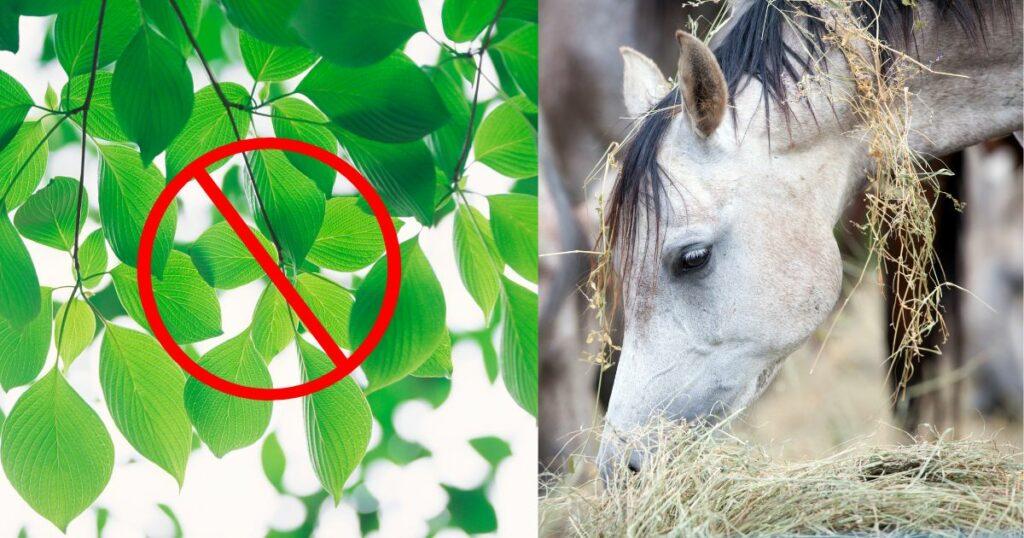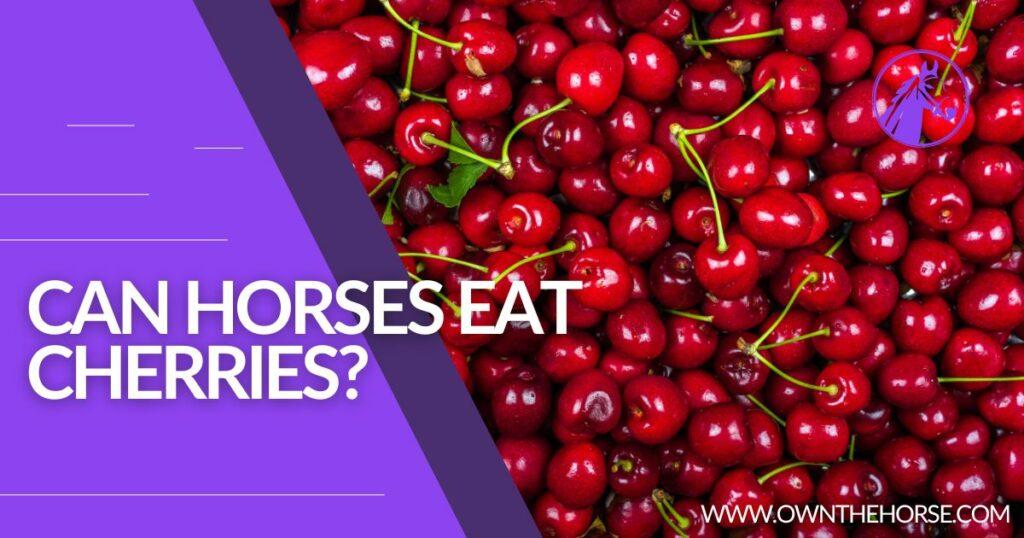As an Amazon Associate we earn from qualifying purchases.
Horse owners often seek to vary their equine companion’s diet, ensuring they receive all of the necessary nutrients and preventing boredom. One such variation might include offering cherries as a treat. However, before providing any new food item to a horse’s diet, it is important to understand any potential benefits or risks associated with that food.
Cherries, like most fruits, are rich in vitamins and other nutrients that can be beneficial to a horse’s overall health. However, cherries can also pose risks if fed improperly or in excessive amounts. In the following paragraphs, we will explore the key factors to consider when deciding if cherries are a suitable addition to your horse’s diet.
Can Horses Eat Cherries
What Makes Cherries Appealing
Cherries are a delicious and nutritious fruit, packed with vitamins, minerals, and antioxidants. They can be an appealing treat for horses due to their sweet taste and juicy texture. Cherries are also known to have potential health benefits, as studies have found that they can help reduce inflammation and muscle soreness in humans and even in horses.
The Role of Moderation
While cherries may be a tasty treat for horses, it is important to maintain moderation when offering them. As with any treat, horses should not be allowed to consume large quantities of cherries as this could lead to potential health risks. Horses primarily thrive on a diet of grasses and hay, and their digestive systems are not designed to handle large amounts of fruit. Offering cherries as an occasional treat can be a safe and enjoyable way for horses to snack on something different.
Potential Choke Hazard
It is essential to be cautious of potential choking hazards when feeding cherries to horses. The pits in cherries can pose a serious risk if swallowed. To eliminate this risk, it is highly recommended to remove the pits from the cherries before offering them to horses. Additionally, cutting the cherries into smaller pieces can help ensure they are safer to eat and minimize the risk of choking.
Nutritional Content
Vitamins and Minerals
Cherries are a nutritious fruit that contains various vitamins and minerals essential for maintaining good health. They are particularly rich in vitamins A and C. Vitamin A, present in the form of beta-carotene, supports healthy eyesight and immune functions, while vitamin C is an essential antioxidant that enhances the immune system and supports tissue growth and repair. In addition, cherries contain significant amounts of magnesium and potassium, two essential minerals that contribute to muscle function, nerve health, and overall electrolyte balance.
Dietary Fiber
Cherries also provide a decent amount of dietary fiber, a crucial component for maintaining a healthy digestive system. Fiber helps regulate digestion, supports healthy gut bacteria, and can aid in weight management by providing a feeling of fullness. Including cherries in a horse’s diet might contribute to the overall fiber intake; however, it is essential to ensure they do not displace the required intake of hay, which is the primary source of fiber for horses.
Sugar Content
While cherries provide valuable nutrients, they also contain sugar, which might be a concern for some horse owners. An excessive intake of sugar can lead to health issues, such as obesity and metabolic disorders in horses. Therefore, it is vital to provide cherries in moderation and consider the horse’s overall diet and health condition. Additionally, be sure to remove the pits, as they can pose a choking hazard or release chemicals harmful to horses when broken.
Health Risks
Cyanide Poisoning
One major concern with horses consuming cherries is the potential for cyanide poisoning. The pit, leaves, and stems of cherries contain cyanogenic glycosides, which can break down and release hydrogen cyanide in the digestive tract when consumed. The presence of these toxins in cherries may cause rapid breathing, increased heart rate, muscle tremors, and even death in horses if consumed in large quantities. It is crucial to remove the pits and other toxic parts of cherries before offering them to horses.
Digestive Problems
Cherries also pose potential digestive problems for horses. Due to their high sugar content (fructose), excessive consumption of cherries can lead to gastrointestinal issues such as colic, bloating, or diarrhea. The high sugar content can also disrupt the natural balance of bacteria in the digestive tract, leading to further complications. Offering cherries occasionally and in moderation can help prevent these issues.
Obesity and Insulin Resistance
Another aspect to consider when feeding cherries to horses is their nutritional value. While cherries do provide some vitamins and antioxidants, their high sugar content can contribute to obesity and insulin resistance if consumed in excessive amounts. Long-term overconsumption of cherries may increase a horse’s risk of developing metabolic disorders like Equine Metabolic Syndrome. To maintain a balanced diet, it is essential to limit the number of cherries a horse consumes and to use them as a treat rather than a primary food source.
Precautions and Alternatives
Safe Fruit Options
When it comes to feeding horses, it is essential to provide them with a well-balanced diet. Horses can enjoy various fruits as occasional treats, but some fruits are safer than others. Apples, pears, watermelon, bananas, oranges, and strawberries are generally considered safe and healthy for horses to consume in moderation. Carrots can also be a nutritious and delightful treat.
Evaluating the Risks
While cherries might seem tempting, they can pose dangers to your horse’s health. The pits of cherries contain a compound called cyanogenic glycosides, which releases cyanide when ingested. This can lead to poisoning if the horse eats large quantities of cherries. It is best to consult with a vet or veterinarian before introducing any new feed or treat to your horse’s diet.
Recognizing Toxicity Symptoms
If you suspect your horse has consumed cherries or any other potentially toxic fruit, it is crucial to be aware of the signs of poisoning. The symptoms may include difficulty breathing, increased heart rate, tremors, weakness, and even collapse. In such cases, seek immediate assistance from a veterinarian, as timely treatment is vital for your horse’s recovery.
Being aware of the risks and providing your horses with safe and nutritious alternatives can help ensure their well-being. It is always best to consult a trusted veterinarian when there are concerns or questions about your horse’s diet.
Types of Cherries and Toxicity
Sweet vs Sour Cherries
Cherries come in two main types: sweet and sour. Sweet cherries (Prunus avium) are the type often found in supermarkets and are commonly enjoyed as a snack or used in desserts. Sour cherries (Prunus cerasus), on the other hand, are less sweet and are often used in cooking or making preserves due to their tangy flavor. Both sweet and sour cherries are members of the Prunus genus, which is part of the larger nightshade family.
Cherry Tree and Livestock Hazards

While cherries themselves might not pose a significant health risk to horses and livestock, certain parts of the cherry tree can have harmful effects. The leaves, stems, and pits of cherry trees contain cyanogenic glycosides, which when broken down release hydrogen cyanide gas, a toxic substance to animals. Chokecherry trees (Prunus virginiana) are a particularly dangerous type as they contain higher amounts of cyanogenic glycosides.
Both cherry tree leaves and wilted leaves pose risks to livestock. Wilted leaves can accumulate prussic acid, which can be even more toxic than fresh leaves. Ingesting these plant parts can lead to cyanide poisoning in animals like horses, cattle, and goats.
Symptoms of cyanide poisoning include rapid breathing, muscle tremors, weakness, and in severe cases, death. If you suspect your horse has consumed cherry tree leaves or any other cyanogenic plants, it is crucial to seek immediate veterinary attention.
In conclusion, while cherries themselves may not significantly harm horses, it is the cherry tree and its various parts that pose a greater risk. Horse and livestock owners should be cautious of the potential hazards and aim to prevent their animals from accessing cherry trees.
Frequently Asked Questions
Are cherries safe for horses to consume?
Cherries can be safe for horses to consume in moderation, as long as the pits, leaves, and stems are removed. These parts of the cherry can be toxic to horses, so it’s important to only offer the cherry fruit itself.
What parts of a cherry can cause harm to a horse?
The pits, leaves, and stems of cherries are the harmful parts to horses. They contain cyanogenic compounds, which can release cyanide when broken down by a horse’s digestive system. Ingestion of these parts can lead to cyanide poisoning and potentially be fatal for the horse.
How do cherries affect a horse’s digestive system?
When fed in moderation and with the pits, leaves, and stems removed, cherries are unlikely to have a significant impact on a horse’s digestive system. However, if a horse consumes too many cherries or ingests their toxic parts, it can experience digestive issues such as colic, bloating, or diarrhea.
What fruits are toxic to horses?
Some fruits that are toxic to horses include avocado, rhubarb, and unripe or green tomatoes. Additionally, the seeds and pits of some fruits, such as cherries, apples, and apricots, contain cyanogenic compounds that can be toxic if ingested by horses.
What precautions should be taken when feeding cherries to horses?
When feeding cherries to horses, it’s essential to remove all pits, leaves, and stems to avoid any potential cyanide poisoning. It’s also important to feed cherries in moderation, as an occasional treat, rather than as a substantial part of their diet.
How can cherries be safely introduced into a horse’s diet?
To safely introduce cherries into a horse’s diet, start by offering a small number of cherries with the pits, leaves, and stems removed. Monitor the horse for any adverse reactions or digestive issues. If there are no problems, cherries can be offered occasionally as a treat, while still ensuring their diet is primarily composed of hay, grass, and other suitable feeds.
Amazon and the Amazon logo are trademarks of Amazon.com, Inc, or its affiliates.

Hey there, I’m Jasmine! I’m a total horse fanatic and have been working with these amazing animals for as long as I can remember. I’m passionate about sharing my love for horses with others and helping them learn more about these majestic creatures. As a professional horse trainer and riding instructor, I’ve developed a deep understanding of equine science and am committed to the welfare of horses. That’s why I founded OwnTheHorse.com, a blog where I share my knowledge and insights with fellow horse enthusiasts. I love connecting with my readers and building a friendly community of horse lovers. Whether you’re a seasoned equestrian or just starting out, I’m here to help and inspire you. Above all, I’m a friendly and compassionate person who truly cares about the well-being of horses and their human companions.

